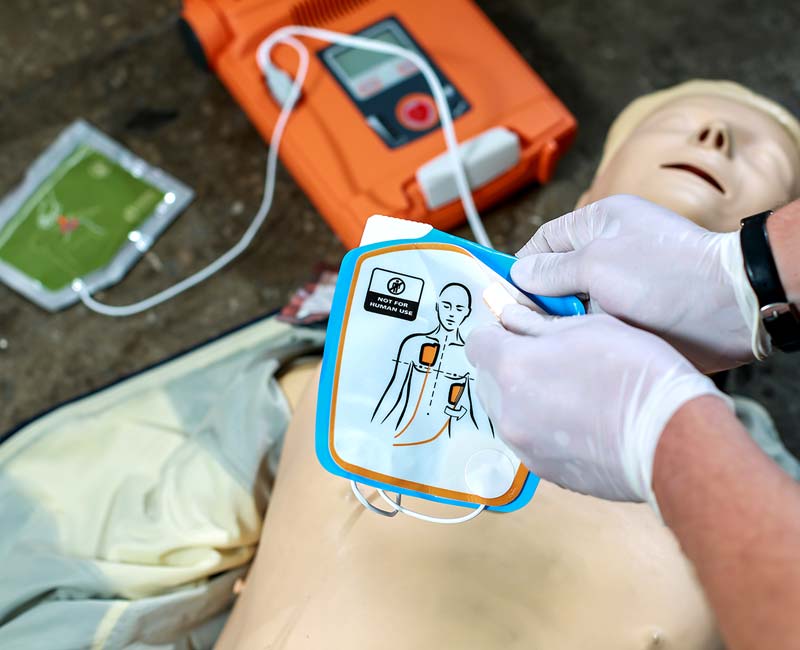In emergencies, every second counts, and having the knowledge and skills to perform Cardiopulmonary Resuscitation (CPR) can mean the difference between life and death. CPR is a life-saving technique that combines chest compressions and artificial ventilation to maintain blood flow and oxygen supply to the brain and other vital organs when a person’s heart stops beating or they stop breathing.
The 4 C’s of CPR provide a simple and effective way to remember the crucial steps involved in this life-saving procedure. By following these steps, you can significantly increase the chances of survival for someone experiencing cardiac arrest or respiratory failure.
The 4 C’s of CPR:
- Call for Help The first and most crucial step in responding to a medical emergency is to call for professional help. As soon as you recognize that someone is unconscious and not breathing normally, immediately call emergency services or instruct someone nearby to do so. Provide clear and concise information about the location, the nature of the emergency, and any relevant details that can assist the emergency responders in reaching you quickly.
- Chest Compressions Chest compressions are the cornerstone of CPR. They help circulate oxygenated blood throughout the body when the heart is not pumping effectively. To perform chest compressions correctly, place the heel of one hand on the center of the person’s chest, with the other hand on top. Keeping your arms straight, apply firm and rapid compressions, pushing down at least 2 inches (5 centimeters) at a rate of 100 to 120 compressions per minute. Proper technique and depth are crucial for effective chest compressions.
- Clear Airway A clear airway is essential for effective breathing and ventilation during CPR. If the person’s airway is obstructed, tilt their head back gently and lift their chin to open the airway. If you see any visible obstruction, carefully remove it while minimizing movement of the neck or spine. A clear airway allows for proper breathing and oxygen delivery to the lungs and bloodstream.
- Continuous Breathing After clearing the airway, provide rescue breaths by pinching the person’s nose closed and sealing your mouth over theirs, creating an airtight seal. Deliver two slow breaths, each lasting about one second, and watch for the chest to rise and fall. Continue alternating between 30 chest compressions and two rescue breaths until emergency responders arrive or the person shows signs of regaining consciousness.
Additional Tips: While the 4 C’s of CPR provide a straightforward framework, there are some additional tips to keep in mind when performing CPR:
Practice and Training: CPR is a skill that requires regular practice and training to maintain proficiency. Consider taking a CPR course from a certified organization, such as the American Heart Association or the American Red Cross, to learn the proper techniques and receive hands-on practice.
Use an Automated External Defibrillator (AED): If an AED is available, use it in conjunction with CPR. AEDs are portable devices that can analyze the heart’s rhythm and deliver an electric shock to restore a normal heartbeat. Follow the voice prompts and visual instructions provided by the AED to maximize its effectiveness.
Rotate Rescuers: If possible, rotate rescuers every two minutes to prevent fatigue and maintain high-quality chest compressions. Consistent and effective chest compressions are crucial for improving the chances of survival.
Encourage Bystander Participation: In a medical emergency, encourage bystanders to assist by taking turns performing chest compressions or calling emergency services. The more people involved, the better the chances of successful resuscitation.
CPR Memphis AHA Training Site
CPR Memphis: CPR Memphis, an American Heart Association training site, offers high-quality CPR training courses to equip individuals with the skills and confidence to respond effectively in emergencies. With a focus on stress-free and hands-on learning, CPR Memphis provides initial certifications and renewals in BLS for Healthcare Providers, ACLS, PALS, and CPR and First Aid courses.
Whether you’re a healthcare professional, a teacher, a parent, or simply someone who wants to be prepared for emergencies, CPR Memphis offers comprehensive training tailored to your needs. Their experienced instructors ensure that each participant receives personalized attention and ample opportunities to practice and master the life-saving techniques.
By choosing CPR Memphis for your CPR training, you’ll gain the knowledge and skills necessary to potentially save a life. Don’t wait until it’s too late – enroll in a CPR course today and become a hero in your community!
Conclusion
Mastering the 4 C’s of CPR is an invaluable skill that can make a life-saving difference in emergencies. By following these simple steps – Call for help, administer Chest compressions, Clear the airway, and provide Continuous breathing – you can significantly increase the chances of survival for someone experiencing cardiac arrest or respiratory failure.
However, it’s crucial to receive proper training and certification to ensure you have the knowledge and skills to perform CPR effectively. That’s where CPR Memphis comes in – a trusted American Heart Association training site offering top-notch CPR certification in Memphis.
Take action when an emergency strikes. Take action today and enroll in a CPR certification course at CPR Memphis. Their experienced instructors will guide you through hands-on training, ensuring you gain the confidence and proficiency to respond calmly and effectively in life-threatening situations.
Empower yourself with the ability to save lives. Visit acls-bls-memphis.com or call (901) 438-4200 to learn more about their CPR certification Memphis courses and schedule your training today. By mastering the 4 C’s of CPR and obtaining your certification, you’ll be better prepared to make a potentially life-saving difference when it matters most.





